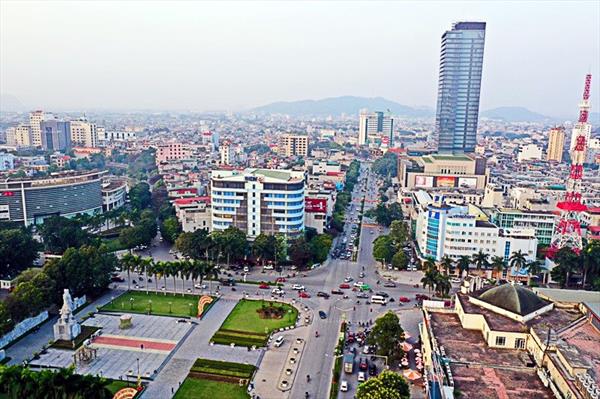Approving the task of formulating a master plan for the restoration and restoration of the Perfume Pagoda relic
The groundbreaking ceremony for these expressways was held online from the main point in Ho Chi Minh City, with the participation of Prime Minister Phạm Minh Chính and other locations in Bà Rịa - Vũng Tàu and Đắk Lắk.
The Ho Chi Minh City Beltway 3, with a total investment of nearly VND 75.4 trillion, spans over 76 km and stands as the largest project. The route traverses Ho Chi Minh City, Bình Dương, Đồng Nai, and Long An, divided into 8 component projects. Each province executes two projects, involving land clearance and construction.

Perspective of Tan Van intersection of Ring Road 3 project when completed. Photo: Traffic Department
Ho Chi Minh City initiated the project earliest and is also where the beltway passes through the longest stretch, covering over 47 km with a total investment of over VND 41.4 trillion. The provinces of Binh Duong, Dong Nai, and Long An are also planning to commence the remaining sections of the route in June.
Beltway 3 starts from the intersection of the Ben Luc - Long Thanh expressway (Nhon Trach district, Dong Nai province) and ends at the intersection of the Ben Luc - Long Thanh expressway (Ben Luc district, Long An province). Once completed, this beltway, along with the Ben Luc expressway, will create a traffic loop around Ho Chi Minh City, minimizing the need for vehicles to travel through the city center.
In Phase 1, the project will construct 4 lanes in the middle, with parallel roads on both sides passing through residential areas. The entire route is expected to be completed in 2026, opening up space for the development of industrial corridors, connecting multiple seaports, reducing travel time and logistics costs. The project is expected to create regional connectivity, promoting the development of the Southern Key Economic Region.

Direction of Bien Hoa - Vung Tau expressway. Graphics: Thanh Nhan
The Bien Hoa - Vung Tau Expressway spans approximately 53.7 km, traversing the provinces of Dong Nai and Ba Ria - Vung Tau. The starting point of the route connects to the bypass of National Highway 1, passing through Bien Hoa City (Dong Nai province), and the endpoint is at the intersection of National Highway 56 in Ba Ria - Vung Tau City.
With a total investment of VND 17.837 trillion from the state budget, the project is divided into three components, with localities through which the route passes and the Ministry of Transport jointly overseeing implementation. In the initial phase, the expressway will be constructed with 4-6 lanes, and it is anticipated to be completed by 2026. Upon operation, the road will connect to the eastern section of the North - South expressway, Long Thanh Airport, seaports, and various economic centers, contributing to the overall development of the Southeastern region.
The Khanh Hoa - Buon Ma Thuot Expressway, with a total investment of VND 21.935 trillion and a length of approximately 117.5 km, links the provinces of Khanh Hoa and Dak Lak. The route is divided into three component projects, with the Ministry of Transport and the two localities overseeing implementation. The project commences at the intersection of National Highway 26B - National Highway 1 (Ninh Hoa town, Khanh Hoa province) and concludes at the intersection with Ho Chi Minh Road, east of Buon Ma Thuot City (Dak Lak province).
In Phase 1, the construction includes 4 lanes, each 17 meters wide, with an anticipated operational date in 2027. Once completed, this expressway will create a horizontal axis linking the Central Highlands with the South Central Coast, connecting the North - South expressway, Ho Chi Minh Road, National Highway 1, coastal roads, and more. This project is expected to significantly contribute to the development of the region.

Direction of the Chau Doc - Can Tho - Soc Trang Expressway. Graphics: Thanh Huyen
One day earlier, the Chau Doc - Can Tho - Soc Trang Expressway, spanning over 188 km and passing through four provinces in the Mekong Delta, with a total investment of nearly VND 44.7 trillion, was also inaugurated. The starting point of the route connects to National Highway 91 in Chau Doc City, An Giang province, and the endpoint is at the Tran De Port, Soc Trang province. Notably, the section passing through An Giang is nearly 57 km, Can Tho around 38 km, Hau Giang approximately 37 km, and over 56 km through Soc Trang.
In Phase 1, the project will construct 4 lanes, each 17 meters wide, allowing vehicles to travel at a speed of 80 km/h. Upon completion, the road surface will be expanded to over 32 meters with 6 lanes. The entire route is expected to be completed in 2027, forming a vital transportation route horizontally across the Mekong Delta region.
This expressway will connect the North - South expressway along the vertical axis, alleviating traffic on National Highway 1, the N1 route, National Highway 91, and coastal roads. Simultaneously, the project will contribute to enhancing the transportation network in the region, connecting the economies and societies of the Mekong Delta provinces, as well as Cambodia and other Southeast Asian countries.
(Source: VnExpress.net)






